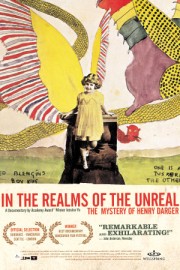In the Realms of the Unreal: The Mystery of Henry Darger
What a peculiar and wonderful documentary this is. Its’ Oscar-winning director- Jessica Yu (she won for the 1996 short subject “Breathing Lessons: The Life and Work of Mark O’Brien”)- makes a key mistake by employing animation to tell her story- for what purpose you’ll find out later- but the story she’s telling is so fascinating, and so singular, that her film holds up despite this problematic technique. The subject of Yu’s documentary- which would be a front-runner for next year’s Oscar if it weren’t already on the shortlist for last year’s (it was released limited on December 22)- you’ve likely never heard of, though once you’ve seen her film, you’ll never forget him. His name is Henry Darger, and to the outside world, there was nothing extraordinary about him. Born in Chicago, his childhood was one of turmoil- his mother died when he was young, and when his father entered a home during his childhood (where he would later die), Henry was put in a religious school, later ending up in a children’s asylum which he would later escape from and return to Chicago- but his adult life consisted of working jobs like being a janitor, living in an apartment which he would isolate himself in, and going to Mass.
A rather uneventful life by any standards, and downright drab- some would say depressing- by modern standards. However, as he was dying in the same home his father did (he would die at the age of 81 in 1973), his landlords- who went to clear out his room- discovered something extraordinary. Paintings, manuscripts, drawings. Works of art in all forms, detailing a rich fantastical world and the centerpiece of the collection- a 15,000 page novel- called, “The Story of the Vivian Girls, in what is Known as the Realms of the Unreal, of the Glandeco-Angelinnian War Storm, Caused by the Child Slave Rebellion.” This was an epic universe, a battle of good vs. evil in its’ most basic terms, told out over several years, in precise detail (even going far enough to not only catalog every death on both sides but the cost of the war as well) and in as rich a fashion that- like Tolkien’s Middle Earth- anyone who wanted to adapt it for the screen would have everything they need to tell the story in front of them. A religious epic to be sure, with the values Darger- who was a self-taught artist, it should be noted- learned going to church his entire life permuating in every aspect of the tale, and a violent one as well- despite the heroes of this story being girls, the warfare is brutal and extreme. This is no children’s story (along with the violence and themes, a particularly odd- and deeply unsettling- touch of Darger’s is to give the girls in his drawings- who are sometimes naked- slight penises, hinting at either homosexual or pedophelian- or both- feelings never acted upon), but a mature, visionary work of art that shows a mind working at its’ capacity to bring it to as vivid and remarkable a life as is possible in writing and painting.
Through interviews with neighbors, we learn about the Darger the world knew- isolated and content, a no-trouble drone in the world, leading a simple life with no complications from the outside world. But in his own words and in descriptions of his work- read mostly by child actor Dakota Fanning (a better choice than some felt)- we learn of the man in his own world- isolated and content, an uncompromising and original artist, creating a complex world the outside world would not be aware of until the end of his life. It wasn’t until 2000 that his apartment- which was preserved after his death and the discovery of his passionate work- would finally be emptied, and his creation would make its’ way into museums and outside of the walls of Darger’s world. The outside world’s gain- an epic work, by an introspective artist who found peace from the cruelities of the real world within the limitless walls of his own cruel, imaginary world, and proof that the greatest art is always done for oneself, not the masses. This is one of the year’s most astonishing films.










